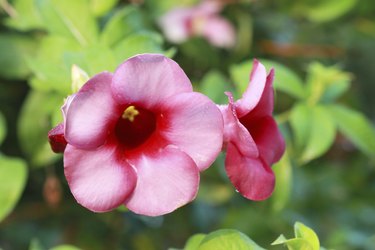
Even in cool northern climates, dipladenia (Mandevilla sanderii) brings the tropics home. Evergreen and thriving in U.S. Department of Agriculture plant hardiness zones 10 through 12, dipladenia gladly overwinters indoors, too. At one time, these shrubby vines occupied their own botanical genus, but now they fall under mandevilla's (Mandevilla spp.) umbrella. With proper care, you can enjoy dipladenia's compact habit and luxuriant, trumpet-like blooms in your garden from year to year.
Starting Dipladenia Right
Video of the Day
For bountiful flowers and healthy foliage, give dipladenia a spot where it receives 6 to 8 hours of sun each day. A location with morning and late afternoon sun, but midday protection, is ideal in hot climates. Dipladenia demands excellent drainage in containers or in the ground. Give it porous, well-draining soil. The plant vines naturally, but not to the extent its mandevilla brethren do. When planting multiple dipladenia vines, space the plants 24 inches apart. If container-growing these vines, use pots you can move easily. Dipladenia also makes a beautiful hanging basket.
Video of the Day
Balancing Water and Fertilizer
Overwatering is dipladenia's enemy. The vine's tuberous roots suffocate in overly wet soil. Young plants need consistently moist soil, but established dipladenias should dry out between waterings. The roots manage low water efficiently, but heavy water brings on root rot and eventual death. In winter, water dipladenia once per month as cool temperatures and reduced light bring on rest. No fertilizer is needed during the resting period, but dipladenia appreciates extra nutrients while blooming. Feed your plant every two weeks with a high-phosphorus, bloom-enhancing fertilizer, such as 10-30-20. Mix 1/2 teaspoon with 1 gallon of water, and water your dipladenia's soil.
Managing Pests
Dipladenias have few problems when given the conditions they desire. Even so, aphids and spider mites may sneak in. Beneficial lady beetles and predatory mites handle these two pests well. Ready-to-use insecticidal soaps can be used, too. Spray the soap so it contacts the pests thoroughly. Occasionally, dipladenia develops fungal disease. Treat affected plants with fungicide to keep the disease from spreading. Mix 2 teaspoons of liquid copper concentrate with 1 gallon of water and spray all plant parts thoroughly. Repeat the spray every seven to 14 days. Wear gloves, protective clothing and safety eyewear whenever you mix or spray.
Pruning and Protecting
Dipladenias bloom on new growth, so prune the vine hard in late winter. Use sharp bypass pruners, and sterilize the blades with household disinfectant before and after you prune. Remove older, crowded stems; shorten and shape up others. New shoots form at the crown. At summer's end, move your dipladenia indoors before temperatures drop below 50 degrees Fahrenheit. Transplant garden-planted dipladenia to pots. Dig carefully and retain as much of the roots as possible. Use a 3-gallon or larger container for an established plant. When temperatures reliably stay above 50 degrees again in spring, move your dipladenia back outside. If transplanting to the garden, dig your hole the same depth as the plant's root ball, but twice as wide. This give roots room to grow and spread.